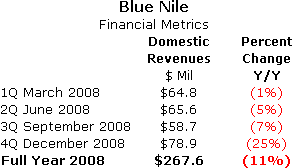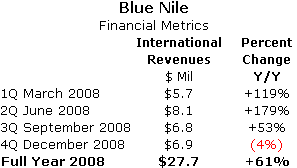IDEX Online Research: Blue Nile Caught in Jewelry Demand Downdraft
March 03, 09
After posting torrid sales growth for several years, the recessionary environment finally caught up with Blue Nile in both the fourth quarter of 2008 as well as the full year.
Blue Nile reported that its fourth quarter sales were down 23.3 percent, however, this is based on 14 weeks in 2008 versus 13 weeks in 2007. On an apples-to-apples basis in the fourth quarter (13 weeks of 2008 versus 13 weeks of 2007), Blue Nile’s sales declined by 26.8 percent. Preliminary sales results for specialty jewelers – most of whom are store-based retailers – show that sales in the fourth quarter of 2008 were down just over 16 percent. This means that Blue Nile lost market share when compared to the performance to specialty jewelry stores.
Trends for the full year of 2008 (52 weeks of 2008 versus the same 52 week period of 2007) reflect trends similar to the fourth quarter. Blue Nile’s sales were down 8.7 percent. Preliminary results for specialty jewelers show that their sales were down by a more modest 4.7 percent.
The graph below illustrates Blue Nile’s fourth quarter 2008 performance versus the universe of specialty jewelers.
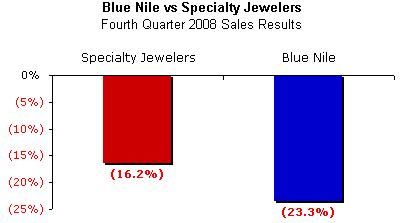
Source: Company Reports
The graph below also compares Blue Nile’s sales performance in the fourth quarter to other major jewelers’ fourth quarter results (two-month holiday period for most jewelers).
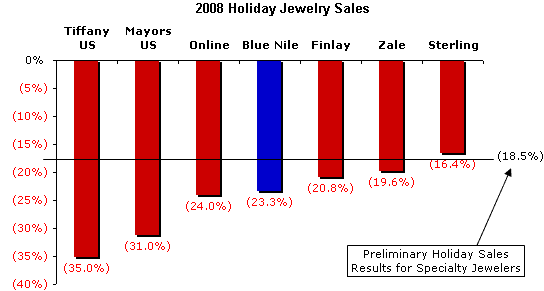
Source: Company Reports
Highlights from Blue Nile’s Fourth Quarter and Full Year
The following are highlights from the company’s October-November-December 2008 calendar quarter as well as the full year. Blue Nile’s results in both the fourth quarter and for the full year reflect an extra week in 2008, due to its fiscal calendar.
Fourth quarter results are shown on the following table. These comparisons are for 14 weeks in 2008 versus 13 weeks in 2007.

Full year results for Blue Nile are summarized on the following table. These comparisons are for 53 weeks of 2008 versus 52 weeks of 2007.
 |
- For the full year, engagement jewelry represented 69 percent of sales, up from 68 percent in 2007.
The average ticket in 2008 for a diamond engagement ring was $6,000, down slightly from the prior year’s $6,200. This is still well above the industry average of an estimated $3,546 for a diamond engagement ring.
- High-end jewelry priced above $25,000 (retail) was the softest category for Blue Nile.
- Sales of non-engagement jewelry were weaker than engagement jewelry.
- The international market offers opportunity for Blue Nile. In 2008, the company expanded its shipping capabilities to over 35 new overseas markets in Europe and the Asia-Pacific region. International sales in 2008 were over $27 million, up about 61 percent from the prior year; they now represent just over 9 percent of corporate revenues.
The tables below summarize domestic sales versus international market sales for Blue Nile by quarter for 2008.
|
|
- In the fourth quarter, total orders declined by about 20 percent. Website traffic was down in the “single-digit range” in the fourth quarter, according to management.
The following table summarizes Blue Nile’s estimated number of orders processed by quarter in 2008. For the full year, Blue Nile processed over 177,000 orders for jewelry.
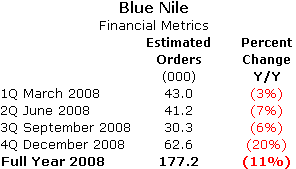 |
- Blue Nile’s selling price per order was $1,370 in the fourth calendar quarter versus $1,411 in the same period last year, a decline of about 4 percent. During the fourth quarter, Blue Nile’s average ticket is lower than other periods of the year because of a higher sales mix of lower-ticket non-engagement jewelry.
The table below summarizes Blue Nile’s average ticket by quarter for 2008.
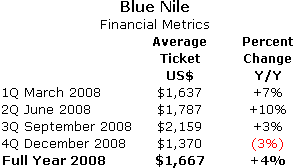 |
- Unfortunately, the company did not break out segment sales in the fourth quarter on the basis of 13-weeks 2008 versus 13-weeks 2007. On the basis of the 14-week period in 2008 versus the 13-week period in 2007, domestic sales declined 24.6 percent. International sales – mostly Canada and the U.K. – were down 4.2 percent. The company attributes the decline in international sales to the strengthening U.S. dollar which made its offerings less of a value. For example, in the fourth quarter, the British pound declined by roughly 23 percent against the dollar. In addition, the deteriorating global economy also had a negative impact on jewelry demand.
Blue Nile management noted that international sales on a constant currency basis would have been positive.
- Blue Nile’s gross margin in the fourth quarter was 20.6 percent versus 21.1 percent in the fourth quarter of the prior year. The 50 basis point decline is due to a sales mix shift. Engagement jewelry, which carries an inherently lower margin, represented a larger percentage of fourth quarter sales in 2008.
- Cash flow was negative by just under $5 million for the full year. Normally, we would not mention this. However, Blue Nile’s business model has been particularly successful (no debt, for example) because its operations have generated positive cash flow. Essentially, the company has been able to shift its inventory risk to its suppliers. However, in a period when sales decline, cash flow will turn slightly negative because vendor payables typically decrease. For a business with nearly $300 million in sales, negative cash flow of $5 million is hardly noticeable. However, it does illustrate that its business model will experience challenges when sales are declining.
Outlook for 2009
Blue Nile management said it would not provide financial guidance in the current environment. However, it did articulate some of its operating and marketing strategies for 2009.
- Blue Nile said that its first quarter sales are running down about 15 percent. That’s not nearly as weak as the fourth quarter. We are hearing similar comments from other jewelers who say that Valentine’s Day sales were reasonable. A surprising number of jewelers reported that their 2009 Valentine’s sales were up.
- Blue Nile’s management noted that demand has been strongest for classic diamond styles. This contrasts with some jewelers who say that fashion jewelry is their strongest category.
- In an attempt to further penetrate international markets, Blue Nile plans to offer goods with prices denominated in local currencies in certain markets. Management did not offer further details on this tactic.
- Blue Nile reduced its workforce in mid-January, and it continues to seek ways to cut costs.
- We expect to see an improvement in Blue Nile’s gross margin in 2009. Management noted that polished diamond prices have been declining. As a result, it expects to pick up some margin benefit by selling diamonds which it purchased at lower costs. However, it is important to note that a cornerstone of Blue Nile’s product offering is “value-priced diamonds.” Thus, we do not expect any more than a 50-to-100 basis point improvement in its gross margin for the year.
Blue Nile’s management noted that it is seeing notable competition from over-inventoried jewelers who are liquidating merchandise at distress price levels. Blue Nile’s strategy is to offer goods at a firm price, without discounting or playing “pricing roulette” which often characterizes store-based jewelers.
- Blue Nile’s inventory declined by about 10 percent at the end of 2008 versus the end of 2007. Management said its inventory is comprised primarily of engagement rings and finished jewelry of classic designs. In short, the company probably has little inventory risk in terms of style.
- Blue Nile expects to generate positive free cash flow in 2009, assuming its sales are around $230 million or better. It is highly unlikely that the company’s sales will fall to that level, in our opinion.
- Blue Nile’s capital expenditure budget for 2009 is a miniscule $2 million, about the same level as in 2008.
- In 2009, Blue Nile management plans to focus on developing an elevated branding message. It offered no specifics about how this would be done.
